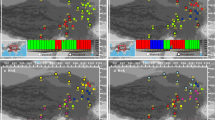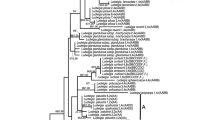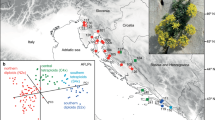Abstract
Amphitropical disjunct distributions between western North America and western South America have intrigued botanists for over a century. Here, specific examples of migration and speciation are investigated using herbaceous species from the phlox family (Polemoniaceae) as a model for considering the timing of dispersal relative to speciation. Comparative DNA sequencing reveals that, in Collomia and Navarretia, the South American species are allopolyploids, suggesting either two dispersals prior to the allopolyploidization event for each species with subsequent extirpation of the diploid progenitors from South America, or allopolyploid formation prior to dispersal with extirpation of these polyploids from North America. Divergence time estimates support a Pliestocene dispersal hypothesis and sequence data indicate that, at least in Collomia, hybridization of the diploid progenitors occurred in South America.
Resumen
Las distribuciones anfitropicales disyuntas entre el oeste de América del Norte y el oeste de América del Sur han intrigado a los botánicos durante más de un siglo. Aquí se investigan ejemplos específicos de migración y especiación usando especies de la familia del Flox (Polemoniaceae) como un modelo para considerar el efecto del orden temporal entre dispersión y especiación. La comparación de sequencias de ADN revela que las especies sudamericanas de Navarretia y Collomia son alopoliploides y sugiere para cada una de ellas, o bien dos eventos de dispersión anteriores a la formación del alopoliploide, seguido por la desaparición de los progenitores diploides en América del Sur, o bien la formación del alopoliploide antes de la dispersión, y la extinción de los progenitores diploides en América del Norte. La estimación de los tiempos de divergencia apoya la hipótesis de una dispersión durante el Pleistoceno, y los datos de las secuencias de ADN indican que, al menos en el caso de Collomia, la hibridación de los progenitores diploides ocurrió en América del Sur.





Similar content being viewed by others
Literature Cited
Alsos, I. G., T. Engelskjøn, L. Gielly, P. Taberlet & C. Brochmann. 2005. Impact of ice ages on circumpolar molecular diversity: insights from an ecological key species. Molecular Ecology 14: 2739–2753.
Aoki, S. & M. Ito. 2000. Molecular phylogeny of Nicotiana (Solanaceae) based on the nucleotide sequence of the matK gene. Plant Biology 2: 316–324.
Axelrod, D. I. 1950. Evolutin of desert vegetation in western North America. Carnegie Institution of Washington Publication 590: 215–306.
Bell, C. D. & R. W. Patterson. 2000. Molecular phylogeny and biogeography of Linanthus (Polemoniaceae). American Journal of Botany 87: 1857–1870.
Björk, C. R. 2002. A new subspecies of Navarretia leucocephala (Polemoniaceae) from vernal pools in Eastern Washington. Madroño 49: 165–168.
Bray, W. L. 1898. On the relation of the flora of lower Sonoran zone in North America to the flora of the arid zones of Chili and Argentine. Botanical Gazette 26: 121–147.
——— 1900. The relationships of the North American flora to that of South America. Science 12: 709–716.
Carlquist, S. 1966. The biota of long distance dispersal. Evolution 20: 30–48.
——— 1983. Intercontinental dispersal. Sonderb. Naturwiss. Vereins Hamburg 7: 37–47.
Cruden, R. 1966. Birds as agents of long-distance dispersal for disjunct plant groups of the temperate western hemisphere. Evolution 20: 517–532.
Day, A. G. 1993. New taxa and nomenclatural changes in Allophyllum, Gilia, and Navarretia (Polemoniaceae). Novon 3: 331–340.
——— 1995. Sessile-flowered species in the Navarretia leucocephala group (Polemoniaceae). Madroño 42: 34–39.
Dierschke, T., T. Mandakova, M. A. Lysak & K. Mummenhoff. 2009. A bicontinental origin of polyploidy Australian/New Zealand Lepidium species (Brassicaceae)? Evidence from genomic in situ hybridization. Annals of Botany 104: 681–688.
Fawcett, J. A., S. Maere & Y. van de Peer. 2009. Plants with double genomes might have had a better chance to survive the Cretaceous–Tertiary extinction event. Proceedings of the National Academy of Sciences, USA 106: 5737–5742.
Flory, W. S. 1937. Chromosome numbers in the Polemoniaceae. Cytologia, Fujii Jubilee Volume: 171–180.
Goodspeed, T. H. 1954. The Genus Nicotiana. Chronia Botanica, Waltham, Mass.
Grant V. (1959) Natural history of the Phlox family. Martinus Nijhoff, The Hague.
Gray, A. & J. D. Hooker. 1880. The vegetation of the Rocky Mountain region and a comparison with that of other parts of the world. United States Geological and Geographical Survey of the Territories Bulletin 6: 1–77.
Green, E. S. 2010. Infrageneric relationships within Collomia (Polemoniaceae). M. S. Thesis, Brigham Young University, Provo, UT.
Hoffmann, A., M. T. K. Arroyo, F. Liberona, M. Muñoz & J. Watson. 1998. Plantas altoandinas en la flora silvestre de Chile. Ediciones Fundación Claudio Gay, Santiago.
Hussey, B. M. J., G. J. Keighery, R. D. Cousens, J. Dodd & S. G. Lloyd. 1997. Western weeds: a guide to the weeds of Western Australia. The Plant Protection Society of Western Australia, Victoria Park.
Johnson, L. A. & R. L. Johnson. 2006. Morphological delimitation and molecular evidence for allopolyploidy in Collomia wilkenii (Polemoniaceae), a new species from northern Nevada. Systematic Botany 31: 349–360.
———, ———, L. M. Chan, T. L. Weese, L. D. Busby & S. McMurry. 2008. Nuclear and cpDNA sequences combined provide strong inference of higher phylogenetic relationships in the phlox family (Polemoniaceae). Molecular Phylogenetics and Evolution 48: 997–1012.
Kay, K. M., J. B. Whittall & S. A. Hodges. 2006. A survey of nuclear ribosomal internal transcribed spacer substitution rates across angiosperms: an approximate molecular clock with life history effects. BMC Evolutionary Biology 6: 36.
Lim, K. Y., D. E. Soltis, P. S. Soltis, J. Tate, R. Matyasek, H. Srubarova, A. Kovarik, J. C. Pires, Z. Xiong & A. R. Leitch. 2008. Rapid chromosome evolution in recently formed polyploids in Tragopogon (Asteraceae). PLoS ONE 3: e3353. doi:10.1371/journal.pone.0003353.
McNeill, J., F. R. Barrie, H. M. Burdet, V. Demoulin, D. L. Hawksworth, K. Marhold, D. H. Nicolson, J. Prado, P. C. Silva, J. E. Skog, J. H. Wiersema, & N. J. Turland. 2006. International Code of Botanical Nomenclature (Vienna Code) adopted by the Seventeenth International Botanical Congress Vienna, Austria, July 2005. Regnum Vegetabile, 146. A. R. G. Gantner Verlag, Ruggell
Moore, M. J., A. Tye & R. K. Jansen. 2006. Patterns of long-distance dispersal in Tiquilia subg. Tiquilia (Boraginaceae): implications for the origins of amphitropical disjuncts and Galápagos Islands endemics. American Journal of Botany 93: 1163–1177.
Morrell, P. L., J. M. Porter & E. A. Friar. 2000. Intercontinental dispersal: the origin of the widespread South American plant species Gilia laciniata (Polemoniaceae) from a rare California and Oregon coastal endemic. Plant Systematics & Evolution 224: 13–32.
Müller, K. 2005. SeqState: primer design and sequence statistics for phylogenetic DNA datasets. Applied Bioinformatics 4: 65–69.
Mummenhoff, K. & A. Franzke. 2007. Gone with the bird: late Tertiary and Quaternary intercontinental long-distance dispersal and allopolyploidization in plants. Systematics and Biodiversity 5: 255–260.
Mummenhoff, K., P. Linder, N. Friesen, J. L. Bowman, J.-Y. Lee & A. Franzke. 2004. Molecular evidence for bicontinental hybridogenous genomic constitution in Lepidium sensu stricto (Brassicaceae) species from Australia and New Zealand. American Journal of Botany 91: 254–261.
Otto, S. P. & J. Whitton. 2000. Polyploid incidence and evolution. Annual Reviews of Genetics 34: 401–437.
Ownbey, M. 1950. Natural hybridisation and amphidiploidy in the genus Tragopogon. American Journal of Botany 37: 487–499.
Philippi, R. A. 1895. Plantas neuvas Chilensas, Polemoniaceae. Anales de la Universidad de Chile 90: 211–221.
Porter, J. M. & L. A. Johnson. 2000. A phylogenetic classification of Polemoniaceae. Aliso 19: 55–91.
Posada, D. & K. A. Crandall. 1998. Modeltest: testing the model of DNA substitution. Bioinformatics 14: 817–818.
Puntieri, J. G. & C. A. M. Brion. 2005. Nuevas citas para la flora Argentina: Collomia grandiflora (Polemoniaceae) y Potentilla recta (Rosaceae). Hickenia 3: 227–232.
Pysek, P., J. Sadlo & B. Mandak. 2002. Catalogue of alien plants of the Czech Republic. Preslia, Praha 74: 97–186.
Rambaut, A. 2002. Se-Al sequence alignment editor version 2.0. University of Oxford, Oxford. United Kingdom. http://tree.bio.ed.ac.uk/software/seal/
Raven, P. H. 1963. Amphitropical relationships in the floras of North and South America. Quarterly Review of Biology 38: 151–177.
——— & D. I. Axelrod. 1978. Origin and relationships of the California flora. University of California Publications in Botany 72: 1–134.
Reiche, K. 1910. Polemoniaceae. Estudios criticos sobre la flora de Chile 5: 146–158.
Spencer, S. C. & J. M. Porter. 1997. Evolutionary diversification and adaptation to novel environments in Navarretia (Polemoniaceae). Systematic Botany 22: 649–668.
Spencer, S. C. & A. E. Spencer. 2003. Navarretia willamettensis and Navarretia saximontana (Polemoniaceae), new species from ephemeral wetlands of western North America. Madroño 50: 196–199.
Soltis, D. E. & J. G. Burleigh. 2009. Suviving the K-T mass extinction: new perspectives of polyploidization in angiosperms. Proceedings of the National Academy of Sciences, USA 106: 5455–5456.
Soltis, P. S. & D. E. Soltis. 2000. The role of genetic and genomic attributes in the success of polyploids. Proceedings of the National Academy of Sciences, USA 97: 7051–7057.
——— & ———. 2009. The role of hybridization in Plant Speciation. Annual Review of Plant Biology 60: 561–568.
Soriano, A. 1947. Notas sobre plantas de Patagonia. Boletin de Sociedad Argentina de Botánica 2: 99–106.
Stebbins, G. L., Jr. 1942. Polyploid complexes in relation to ecology and the history of floras. American Naturalist 766: 36–45.
———, ———. 1947. Evidence on rates of evolution from the distribution of existing and fossil plant species. Ecological Monographs 17: 149–158.
Strand, A. E., J. Leebens-Mack & B. G. Milligan. 1997. Nuclear DNA-based markers for plant evolutionary biology. Molecular Ecology 6: 113–118.
Sugiura, T. 1936. Studies on the chromosome numbers in higher plants, with special reference to cytokinesis 1. Cytologia 7: 544–595.
Swofford, D.L. 2002. PAUP* phylogenetic analysis using parsimony (* and other methods), version 4.0b10. Sinauer Associations, Sunderland. MA.
Thorne, R. F. 1972. Major disjunctions in the geographic ranges of seed plants. The Quarterly Review of Biology 47: 365–411.
USDA PLANTS Database. 2010. http://plants.usda.gov/. Accessed 30 September 2010.
Vargas, P., B. G. Baldwin & L. Constance. 1998. Nuclear ribosomal DNA evidence for a western North American origin of Hawaiian and South American species of Sanicula (Apiaceae). Proceedings of the National Academy of Sciences, USA 95: 235–240.
Vijverberg, K., P. Kuperus, J. A. J. Breeuwer & K. Bachmann. 2000. Incipient adaptive radiation of New Zealand and Australian Microseris (Asteraceae): an amplified fragment length polymorphism (AFLP) study. Journal of Evolutionary Biology 13: 997–1008.
Weese, T. L. 2004. Phylogenetic analyses in the phlox family (Polemoniaceae). Ph.D. Thesis, Brigham Young University, Provo, UT.
Wen, J. & S. M. Ickert-Bond. 2009. Evolution of the Madrean-Tehyan disjunctions and the North and South American amphitropical disjunctions in plants. Journal of Systematics and Evolution 47: 331–348.
Wherry, E. T. 1944. Review of the genera Collomia and Gymnosteris. American Midland Naturalist 31: 216–231.
Wilken, D. H. 1978. Vegetative and floral relationships among western North American populations of Collomia linearis Nuttal (Polemoniaceae). American Journal of Botany 65: 896–901.
——— 1982. The balance between chasmogamy and cleistogamy in Collomia grandiflora (Polemoniaceae). American Journal of Botany 69: 1326–1333.
——— 1986. Polemoniaceae. Chromosome Number Reports XCIII. Taxon 35: 899–900.
———, D. M. Smith, J. B. Harborne & C. W. Glennie. 1982. Flavonoid and anthocyanin patterns and the systematic relationships in Collomia. Biochemical Systematics and Ecology 10: 239–243.
Acknowledgements
This research was supported by the U.S. National Science Foundation (Grants DEB-0344837, DBI-0520978, and OISE 0530267). The authors thank M. Belgrano for help with field work and specimen information from S. America, and J. M. Porter for discussions about South American Polemonioideae.
Author information
Authors and Affiliations
Corresponding author
Appendix I
Appendix I
GenBank accession numbers and voucher information. Acronyms following species names correspond to those used in Figs. 2 through 5. For Collomia, genbank numbers are given in the following order: trnk, matK, trnL, trnS, psbM, ITS, PI, g3pdh. For Navarretia, the same order was followed except for g3pdh, which was not included in this study. Semicolons are used to separate genes and commas are used to separate homeologs within genes for the polyploid species. All vouchers are housed at BRY unless indicated by an alternative herbarium within brackets.
Collomia biflora (Ruiz & Pav.) Brand—ARG1 = Sersic s.n. (DQ196463; DQ196886; DQ196955; DQ196934; HQ117098; DQ196896; HQ116874, HQ116875; HQ117235, HQ117236). ARG2 = [BAA 25056] (HQ911803; HQ911925; HQ911968; HQ911789; HQ911892; HQ911836; ---, ---; HQ911783, HQ911784). ARG3 = Belgrano et al. 462 (HQ911804; HQ911926; HQ911969; HQ911790; HQ911893; HQ911837; ---, ---; ---, ---). ARG4 = Belgrano et al. 519 (HQ911806; HQ911928; HQ911971; HQ911792; HQ911895; HQ911838; ---, ---; ---, ---). ARG5 = Belgrano et al. 532 (HQ911805; HQ911927; HQ911970; HQ911791; HQ911894; HQ911839; HQ911962, HQ911963; ---,---). CHL = Thibauat et al. 156 (HQ116975; HQ116935; HQ117058; HQ117020; HQ117099; HQ116834; HQ116876, HQ116877; HQ117237, HQ117238). Collomia grandiflora Douglas ex Lindl.—AZ = Christy 449 [RSA] (HQ911808; HQ911930; HQ911973; HQ911794; HQ911897; HQ911841; ---; ---). B-ARG = Belgrano 550 (HQ911811; HQ911933; HQ911976; HQ911797; HQ911900; HQ911844; HQ911965; HQ911785). CA = Johnson 94-038 (HQ116983; HQ116942; HQ117065; HQ117027; HQ117107; HQ116840; HQ116886; HQ117247). ID = Johnson & Johnson 95-034 (HQ911809; HQ911931; HQ911974; HQ911795; HQ911898; HQ911842; HQ911966; HQ911786). OR = Johnson 93-086 (DQ196461; DQ196884; DQ196953; DQ196932; HQ117106; DQ196906; HQ116885; HQ117246). NV-1 = Johnson 04-151 (DQ196462; DQ196885; DQ196954; DQ196932; HQ117109; DQ196907; HQ116887; HQ117248). NV-2 = Howell s.n. (HQ911807; HQ911929; HQ911972; HQ911793; HQ911896; HQ911840; HQ911967; HQ911787). UT = Johnson & Matheson 03-073 (HQ911810; HQ911932; HQ911975; HQ911796; HQ911899; HQ911843; HQ911964; HQ911788). Collomia linearis Nutt.—CO-1 = Johnson 99-010 (HQ116990; HQ116947; HQ117071; HQ117032; HQ117116; HQ116845; HQ116897; HQ117258). CO-2 = Atwood & Higgins 5752 (HQ911812; HQ911934; HQ911977; HQ911798; HQ911901; HQ911845; ---; ---). ID-1 = Johnson 92-045 [WS] (HQ116988; L34188; AF208170; EU628236; EU628359; AF208200; HQ116894; HQ117255). ID-2 = Johnson 04-168 (DQ196451; DQ196874; DQ196943; DQ196922; HQ117114; DQ196895; HQ116895; HQ117256). NE = Stephens & Brooks 24521 [KANU] (HQ911814; HQ911936; HQ911979; HQ911800; ---; HQ911847; ---; ---). NV = Johnson & Johnson 04-104 (DQ196449; DQ196872; DQ196941; DQ196920; HQ117113; DQ196893; HQ116893; HQ117254). OR = Johnson 97-134 (HQ911813; HQ911935; HQ911978; HQ911799; HQ911902; HQ911846; ---; ---). UT = Thorne et al. 4171 (DQ196450; DQ196873; DQ196942; DQ196921; HQ117115; DQ196894; HQ116896; HQ117257). Collomia macrocalyx Leiberg ex Brand.—OR-1 = Johnson & Johnson 05-071 (HQ116991; HQ116948; HQ117072; HQ117033; HQ117117; HQ116846; HQ116898; HQ117259). OR-2 = Johnson & Johnson 05-079 (HQ116992; HQ116949; HQ117073; HQ117034; HQ117118; HQ116847; HQ116899; HQ117260). Collomia renacta Joyal—NV = Johnson & Johnson 04-107 (DQ196455; DQ196878; DQ196947; DQ196926; HQ117119; DQ196900; HQ116900; HQ117261). OR = Johnson & Johnson 05-103 (HQ116993; HQ116950; HQ117074; HQ117035; HQ117120; HQ116848; HQ116901; HQ117262). Collomia tenella A. Gray—NV = Johnson 06-120 (HQ116998; HQ116954; HQ117078; HQ117039; HQ117126; HQ116852; HQ116908; HQ117269). UT = Johnson 01-025 (DQ196457; DQ196880; DQ196949; DQ196928; HQ117124; DQ196902; HQ116906; HQ117267). Collomia tinctoria Kellogg—ID = Porter 13769 (DQ196445; DQ196868; DQ196937; DQ196916; HQ117130; DQ196889; HQ116912; HQ117273). OR = Johnson 95-048 (HQ117000; HQ116956; HQ117080; HQ117041; HQ117128; HQ116854; HQ116910; HQ117271). Collomia tracyi H. Mason—CA-1 = Johnson 94-075 (DQ196447; DQ196870; DQ196939; DQ196918; HQ117131; DQ196891; HQ116913; HQ117274). CA-2 = Johnson 94-078 (HQ117001; HQ116957; HQ117081; HQ911802; HQ117132; HQ116855; HQ116914; HQ117275). Collomia wilkenii L.A. Johnson & R.L. Johnson—NV1 = Johnson & Johnson 04-105 (DQ196452; DQ196875; DQ196944; DQ196923; HQ117133; DQ196908, DQ196909; HQ116915, HQ116916; HQ117276, HQ117277). NV2 = Johnson & Zhang 05-166 (HQ117002; HQ116958; HQ117082; HQ117043; HQ117134; HQ116856, HQ116857; HQ116917, HQ116918; HQ117278, HQ117279).
Navarretia fossalis Moran—CA = Spencer 4416-21 [RSA] (HQ911911; HQ912008; HQ911878; HQ911987; HQ911822; HQ911855; HQ911937). Navarretia intertexta (Benth.) Hook.—CA-1 = Johnson 93-088 (HQ911918; HQ912015; HQ911885; HQ911994; HQ911829; HQ911864; HQ911939). CA-2 = Johnson 04-038 (HQ911919; HQ912016; HQ911886; HQ911995; HQ911830; HQ911865; HQ911938). Navarretia involucrata Ruiz & Pav.—ARG-1 = Belgrano et al. 470 (HQ911907; EU628547; EU628507; EU628244; EU628367; EU628293; HQ911940, HQ911944). ARG-2 = Belgrano et al. 499 (HQ911908; HQ912005; HQ911875; HQ911984; HQ911819; HQ911852; HQ911941, HQ911943). ARG-3 = Belgrano et al. 551 (HQ911909; HQ912006; HQ911876; HQ911985; HQ911820; HQ911853; HQ911942, HQ911945). Navarretia leucocephala Benth. ssp. bakeri (H. Mason) A.G. Day—CA = Gowen 697(HQ911924; HQ912021; HQ911891; HQ912000; HQ911835; HQ911870; ---, ---). Navarretia leucocephala Benth ssp. leucocephala—CA = Johnson 04-118 (HQ911921; HQ912018; HQ911888; HQ911997; HQ911832; HQ911867; ---, ---). Navarretia leucocephala Benth. ssp. minima (Nutt.) A.G. Day—OR = Johnson 05-198 (HQ911922; HQ912019; HQ911889; HQ911998; HQ911833; HQ911868; HQ911946, HQ911947). Navarretia leucocephela ssp. pauciflora (H. Mason) A.G. Day—CA = Johnson 04-036 (HQ911923; HQ912020; HQ911890; HQ911999; HQ911834; HQ911869; HQ911960, HQ911961). Navarretia myersii P.S. Allen & A.G. Day ssp. myersii—CA = Popp s.n. [DAV] (HQ911920; HQ912017; HQ911887; HQ911996; HQ911831; HQ911866; ---, ---). Navarretia propinqua Suksd.—NV = Howell s.n. (HQ911917; HQ912014; HQ911884; HQ911993; HQ911828; HQ911862, HQ911863; HQ911948, HQ911949). UT = Johnson 04-163(HQ911916; HQ912013; HQ911883; HQ911992; HQ911827; HQ911860, HQ911861; HQ911950, HQ911951). Navarretia prostrata (A. Gray) Greene—CA = Wilken s.n. (HQ117012; HQ116967; HQ117091; HQ117052; HQ117143; HQ116866; HQ116928). Navarretia saximontana S.C. Spencer—UT = Johnson 07-036 (HQ911912; HQ912009; HQ911879; HQ911988; HQ911823; HQ911856; HQ911952, HQ911953). Navarretia sp. nov. 1—CA = Johnson et al. 09-021 (HQ911914; HQ912011; HQ911881; HQ911990; HQ911825; HQ911858; HQ911954). Navarretia sp. nov. 2—CA = Johnson et al. 09-032 (HQ911915; HQ912012; HQ911882; HQ911991; HQ911826; HQ911859; HQ911955). Navarretia sp. nov. 3—UT = Johnson & Johnson 05-197 (HQ911913; HQ912010; HQ911880; HQ911989; HQ911824; HQ911857; HQ911956). Navarretia subuligera Greene—CA-1 = Johnson & Zhang 04-135 (HQ117016; HQ116970; HQ117094; HQ117055; HQ117146; HQ116869; HQ116932). CA-2 = Johnson & Gowen 09-052 (HQ911906; HQ912004; HQ911874; HQ911983; HQ911818; HQ911851; ---). CA-3 = Spencer 568-82 [RSA] (HQ911905; HQ912003; HQ911873; HQ911982; HQ911817; HQ911850; ---). Navarretia tagetina Greene—CA-1 = Johnson 04-024 (HQ911903; HQ912001; HQ911871; HQ911980; HQ911815; HQ911848; HQ911957). CA-2 = Johnson 04-046 (HQ117017; HQ116971; HQ117095; HQ117056; HQ117147; HQ116870; HQ116933). CA-3 = Johnson & Zhang 05-164 (HQ911904; HQ912002; HQ911872; HQ911981; HQ911816; HQ911849; ---). Navarretia willamettensis S.C. Spencer—OR = Johnson & Halse 05-208 (HQ911910; HQ912007; HQ911877; HQ911986; HQ911821; HQ911854; HQ911958, HQ911959).
Rights and permissions
About this article
Cite this article
Johnson, L.A., Chan, L.M., Pozner, R. et al. Allotetraploids in Patagonia with Affinities to Western North American Diploids: Did Dispersal or Genome Doubling Occur First?. Bot. Rev. 78, 288–306 (2012). https://doi.org/10.1007/s12229-012-9101-8
Published:
Issue Date:
DOI: https://doi.org/10.1007/s12229-012-9101-8




